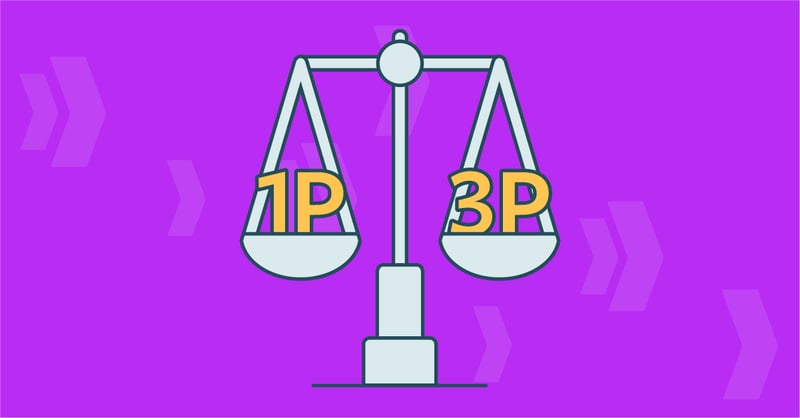
When you sell your products on Amazon, there are a number of decisions you need to make regarding what your business model will look like on the marketplace—one of them being which selling model makes the most sense for you. On Amazon, you have two options: selling first-party (1P) to Amazon, or selling third-party (3P) through the marketplace.
Let’s take a look at the difference between these two models, as well as the pros and cons of each, in order to help you decide which is best for your brand.
Amazon 1P vs. 3P: What's the difference?
While 1P and 3P solutions have a range of pros and cons, the difference between the two is rather straightforward, so let’s break down the fundamentals of what each of these mean:
- First-party (1P) - Vendor Central: You sell your products directly to Amazon who will then sell and ship those products for you directly to the consumer. Essentially, you’re selling your products wholesale to Amazon, who is then managing your presence in the marketplace. When you sell 1P, you sell via a Vendor Central account on Amazon.
- Third-party (3P) - Seller Central: You sell your products directly to consumers on the Amazon marketplace, either on your own or with the assistance of other sellers or agencies. Amazon marketplace sellers are responsible for the logistics, advertising, and marketing of your products on Amazon—however, you still have the option to use the fulfillment by Amazon (FBA) shipping program. When you sell 3P, you sell via a Seller Central account on Amazon.
Pros and cons of selling 1P
Remember, as a 1P seller you are selling directly to Amazon through Vendor Central, and they are in control of how your products are sold on the marketplace.
Pros:
- Receiving bulk orders directly from Amazon: It feels great to log in on Monday and already have a purchase order from Amazon sitting in your inbox. You essentially know what to expect and it’s a very routine process.
- Perceived credibility of products sold directly by Amazon: Some shoppers on Amazon like to see “Sold by Amazon” when they’re shopping online. It gives them the security that their products will arrive on time and without hassle.
Cons:
- Loss of control over pricing and branding: Amazon can change the price of your products without telling you, even if it breaks your MAP (minimum advertised price) policy. In addition, they’re able to make changes to your product descriptions and visual listing elements—and it’s extremely difficult to get these assets live once Amazon has taken them down.
- Issues contacting Amazon Seller Support: When 1P sellers run into problems on Vendor Central, they will have to contact Amazon Seller Support using case management—which can be time-consuming and difficult to manage on your own. Unfortunately, there’s high probability 1P sellers won’t have a contact at Amazon to discuss issues with.
- Inconsistencies with bulk orders: In the past, there have been issues with thousands of sellers not receiving their regular purchase orders. Selling 1P means you are at the whim of Amazon—they can make changes to orders or stop purchasing whenever they choose.
- Long payment terms mean waiting for your paycheck: Selling direct to Amazon comes with long payment terms—which means you may not receive a check for your products sold until 90 days after.
Pros and cons of selling 3P
As a 3P seller, you sell your products directly to consumers on the Amazon marketplace using Seller Central and you maintain control over all aspects of your brand and products.
Pros:
- Greater control over your product listings and branding: Selling 3P gives you greater control over your product listings—you are able to run advertising promotions, alter and optimize the product detail page, and make changes to your Amazon marketing strategy when selling 3P.
- Control over your product’s pricing: When you decide to sell 3P, you also have control over your product’s pricing on Amazon. You’re able to ensure your MAP (minimum advertised price) policy is followed and not violated by Amazon or any rogue sellers.
- Better margins: If you decide to sell 3P, you’re able to create retail margins instead of lower, wholesale margins that are associated with selling directly to Amazon.
Cons:
- 3P sellers may be subject to more Amazon marketplace fees: Depending on whether you sell yourself, or to other third-party seller(s) you partner with, fees such as variable referral fees and fulfillment fees may be even more extravagant than selling directly to Amazon.
- With great control, comes great responsibility: Having control over every aspect of your product listings is great because you can make any and all changes, as well as create a cohesive story, Amazon store, and messaging for your brand. However, if something goes wrong, you as the seller are responsible for fixing it—whether that’s contacting Amazon Seller Support or finding the solution yourself.
- Lose the benefit of 100% Amazon rating: Shoppers like to purchase products directly from Amazon because they know Amazon has a 100% customer rating. Selling 3P means you will have the added weight of managing your seller feedback, customer messages, and overall brand reputation in the marketplace.

So ultimately, should you choose 1P or 3P on Amazon?
For sellers who want a set-it-and-leave-it Amazon strategy, the 1P selling model may be a tempting solution. But for brands who want to take control of their strategy, stay competitive, and really grow their Amazon sales, the 3P model is the way to go.
To make selling 1P or 3P more convenient and less time or resource-heavy, you can partner with an Amazon agency or a third-party seller (this post helps explain the differences) and have them work on behalf of your team:
- Working with an agency consultant like SupplyKick to help you manage the day-to-day of selling on Vendor Central or Seller Central can free up your time to focus on other areas and channels for your business. We provide guidance and execution on your Amazon strategy, case management and reviews, A+ content, photography, video, and listing updates, Storefront optimization, advertising campaigns and deals, inventory forecasting, and more—customized based on your growth goals.
- If you go the 3P route, selling to a single, reliable third-party seller like SupplyKick allows you to maintain marketplace control, expand your brand presence, and gain all of the expertise needed to be successful on Amazon, while still receiving regular wholesale purchase orders. We also take advertising, marketing, inventory management, returns, customer service, compliance, and much more off of your plate.
- Already using Vendor Central and looking to make the switch to Seller Central? We can help with that, too.
Connect with us to learn more about the different approaches to selling on Amazon and how to figure out which option is best for you to find long-term success and growth in the marketplace.


